Reading the Pfizer annual reports and browsing their website triggered my curiosity about the links between Pfizer, BioNTech and the Bill & Melinda Gates Foundation (BMGF). Dr. Susan Desmond-Hellman, a Pfizer non-executive director, proved to be an important link between Pfizer and BMGF. She was president of Product Development at Genentech between 2005 and 2009. Genetech is a biotech company owned by Roche which seeks to discover and develop groundbreaking medicines for life threatening diseases. Dr. Desmond-Hellman subsequently became CEO of BMGF until 2020 when she stepped down to join the Pfizer board.
BioNTech is a German based biotechnology group which focuses on developing immunotherapies for cancer and other diseases. It was founded in 2008 by the husband and wife team of Professor Ugur Sahin and Dr. Ozlem Tureci and backed by the Strugmann brothers. The latter are serial entrepreneurs who have built and sold numerous pharmaceutical companies and made billions in the process.
BioNTech is Pfizer’s partner in developing the COVID-19 vaccines, each party receives 50% of this vaccine’s revenues. BioNTech had been working on various mRNA therapeutics for years and had a relationship with Pfizer since 2018, developing a flu vaccine for them. Pfizer and BioNTech started working on a COVID-19 vaccine in January 2020, way before us mere mortals knew about a once in a lifetime pandemic. By April 2020, Pfizer had agreed to fund 100% of the development costs of the BNT162 vaccine program to prevent COVID-19. Pfizer astonishingly committed up to US$748 million to this vaccine development whilst BioNTech had no liability to contribute or repay any of the funding in the event that the vaccine was unsuccessful. If the vaccine was successful, BioNTech agreed to repay 50% of the development costs out of its share of vaccine revenues. Pfizer initially paid US$185 million to BioNTech which included subscribing for BioNTech shares to the value of US$113 million. Those shares are currently worth US$326 million, not a bad return over two years.
BioNTech’s major shareholders are the Strugmann brothers through their investment vehicle AT Impf GmbH (47.3%) and Professor Ugur Sahin (17.3%). BioNTech shareholders have been very patient, watching the company clock up significant losses over the years but their patience has been rewarded with BioNTech’s current market capitalization of US$33 billion on Nasdaq.
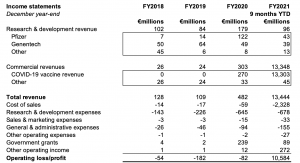
Reviewing the above table, a couple of things may be evident:
- The majority of BioNTech’s revenue pre 2021 (December year-end) was derived from Pfizer and Genentech
- The German government advanced €239 million in 2020 and €89 million in 2021 to BioNTech to develop a COVID-19 vaccine
- BioNTech is due to release its audited results for FY2021 on 30 March 2022. Year-to-date operating profit for the 9 months ended 30 September 2021 was €10.6 billion, a massive turnaround from losses in prior years
The stock market is clearly skeptical about the sustainability of BioNTech’s profitability. A market capitalization of US$33 billion versus operating profit of US$11.6 billion? Seems a very low earnings multiple.
BMGF entered into an agreement with BioNTech in August 2019 for them to develop immunotherapies for the prevention and treatment of HIV, TB and infectious diseases. To seal their relationship, BMGF acquired ±3 million BioNTech shares for US$55 million. So the circle is complete, ex BMGF CEO (having previously worked with Genentech) joins Pfizer board in 2020, BioNTech collaborates with Pfizer to develop a COVID-19 vaccine in less than a year, BioNTech is in cahoots with BMGF and Genentech. Happenstance?
I suddenly remembered that BMGF was the second largest contributor to the WHO in 2020. How eerie is that?
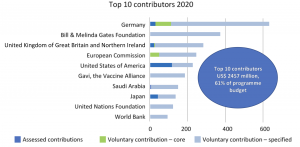
I tend to avoid conspiracy theories, but I am left wondering about BMGF’s involvement with all these COVID-19 role players. Are you aware that the John Hopkins Center for Health Security, in partnership with the World Economic Forum and BMGF, hosted a high-level simulation exercise for pandemic preparedness and response in New York on 18 October 2019? Too many coincidences me thinks.
Stay safe and all the best from BeechieB.

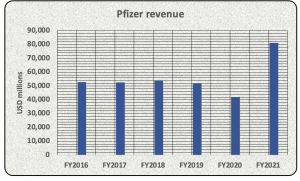 The above chart depicts Pfizer’s stagnating revenue until FY2021. Revenue in FY2020 was USD41.9 billion, in 2021 it increased by 94%. Not too shabby at all. And there is more good news to come since management are forecasting to produce 4 billion COVID-19 vaccines in 2022. They also have a new oral COVID medication called Paxlovid coming onto the market, having received FDA emergency use approval in December 2021. December seems to be a very good month for them. Management are optimistic that Paxlovid will deliver USD22 billion of revenue for the group in FY2022.
The above chart depicts Pfizer’s stagnating revenue until FY2021. Revenue in FY2020 was USD41.9 billion, in 2021 it increased by 94%. Not too shabby at all. And there is more good news to come since management are forecasting to produce 4 billion COVID-19 vaccines in 2022. They also have a new oral COVID medication called Paxlovid coming onto the market, having received FDA emergency use approval in December 2021. December seems to be a very good month for them. Management are optimistic that Paxlovid will deliver USD22 billion of revenue for the group in FY2022.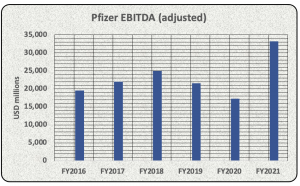
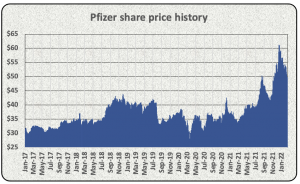
Recent Comments